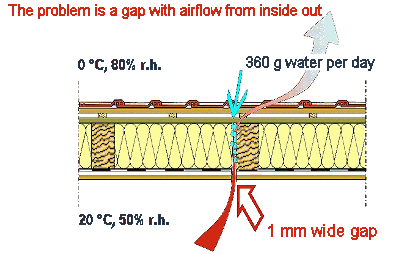This is an old revision of the document!
Table of Contents
Why build an airtight house? – Leakage problems
The external envelope of a building should be as airtight as possible and this doesn’t only apply to Passive Houses.
- building damage caused by water vapour that is transported in air draughts can only be prevented by airtightness of the envelope (see illustration). Building damage is mostly due to the absence of airtightness in the roof area.
- Draughty living spaces and cold air pockets are no longer acceptable for inhabitants: a truly airtight method of construction leads to greater comfort.
- Ventilation systems with supply air and exhaust air spaces only function if the building envelope is sufficiently airtight.
- Airtightness results in better sound protection
Therefore, in accordance with construction technology regulations, a good level of airtightness is generally required today, and rightly so. This applies even more for a comfortable Passive House.
Regarding energy saving construction, airtightness isn’t a pastime, it is vital for the prevention of moisture penetration in building components. As the illustration shows, air flowing out from leaks transports substantial amounts of moisture into the construction. As the air cools on the way out, the water in the air condenses and remains inside the construction.
Airtightness should not be confused with thermal insulation. Both are important for the building envelope, but they must be implemented independently of each other:
- A well-insulating building component doesn’t have to be airtight: e.g. one can easily “blow through” a mat of coconut fibre, cellulose filling or mineral wool insulation. These materials are very good insulators, but they are not airtight. The only insulation material that can also be used as an airtight layer is foam glass.
- Conversely, an airtight building component doesn’t have to be insulating, e.g. an aluminium sheet is absolutely airtight, but has practically no insulating effect.
Airtightness is an important requirement for energy-saving construction, but it is not the most important one (as sometimes misrepresented by popular publications - good insulation is the most essential requirement).
Airtightness should not be confused with diffusion impermeability either: for example, oiled paper is airtight but diffusion permeable. Ordinary interior plaster (gypsum plaster, lime plaster, render, or fibre reinforced loam render) is also sufficiently airtight while being diffusion permeable at the same time.
Requirements for Airtightness within Passive Houses
For a quality assured Passive House (certificat of the PHI) an airtightness with a very low remaining leakage is required:
The n50 value has to be not higher than 0.6 h-1.
This is a quite demanding requirement, but experience has shown
- after some learning gained with first built projects ore a Passive House course, these very good values can be achieved regularly.
- the costs for achieving these values are not higher than those to achieve less demanding ones
- these values guarantee a good performance of the building: moisture problems are avoided this way
- the energy conservation by these measures is significant
- there is an additional benefit for comfort avoiding drafts

